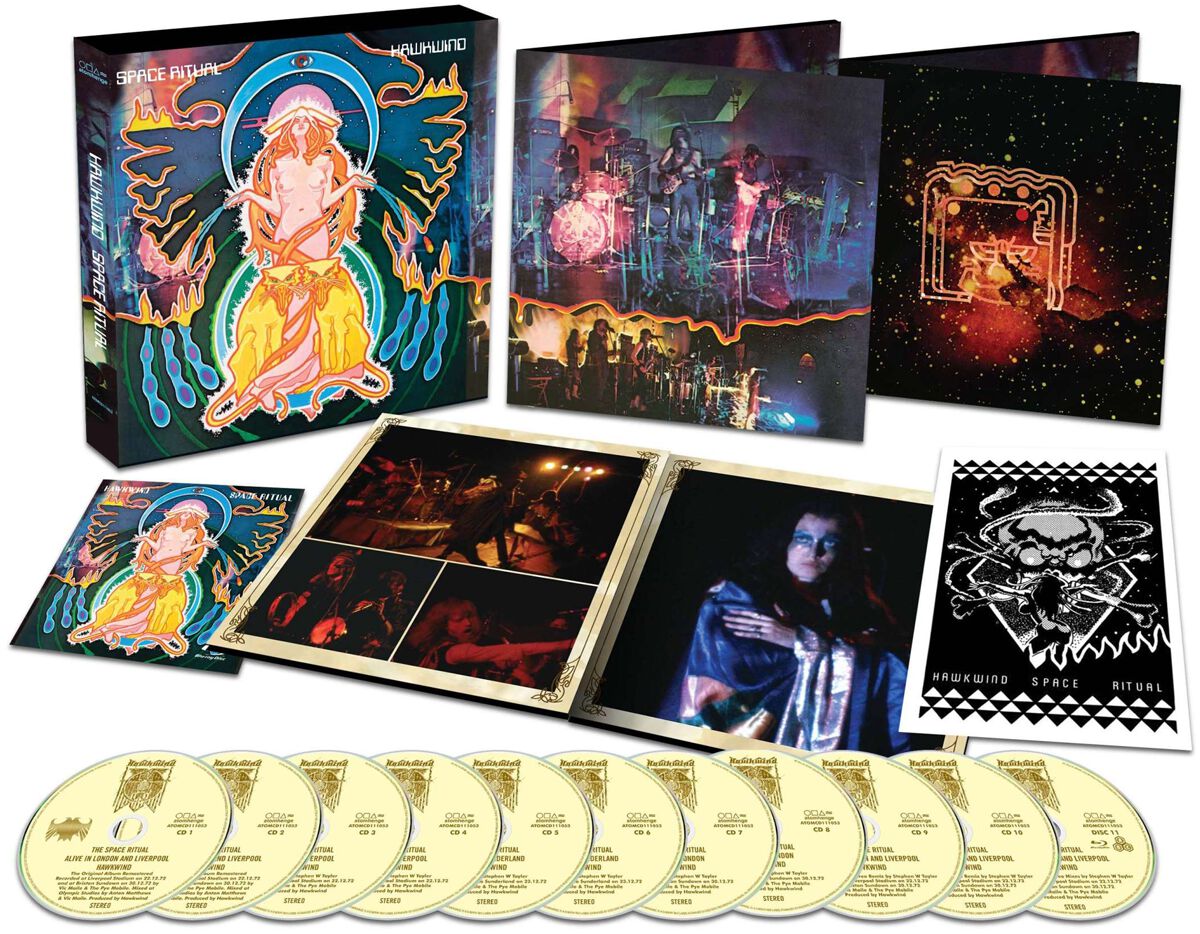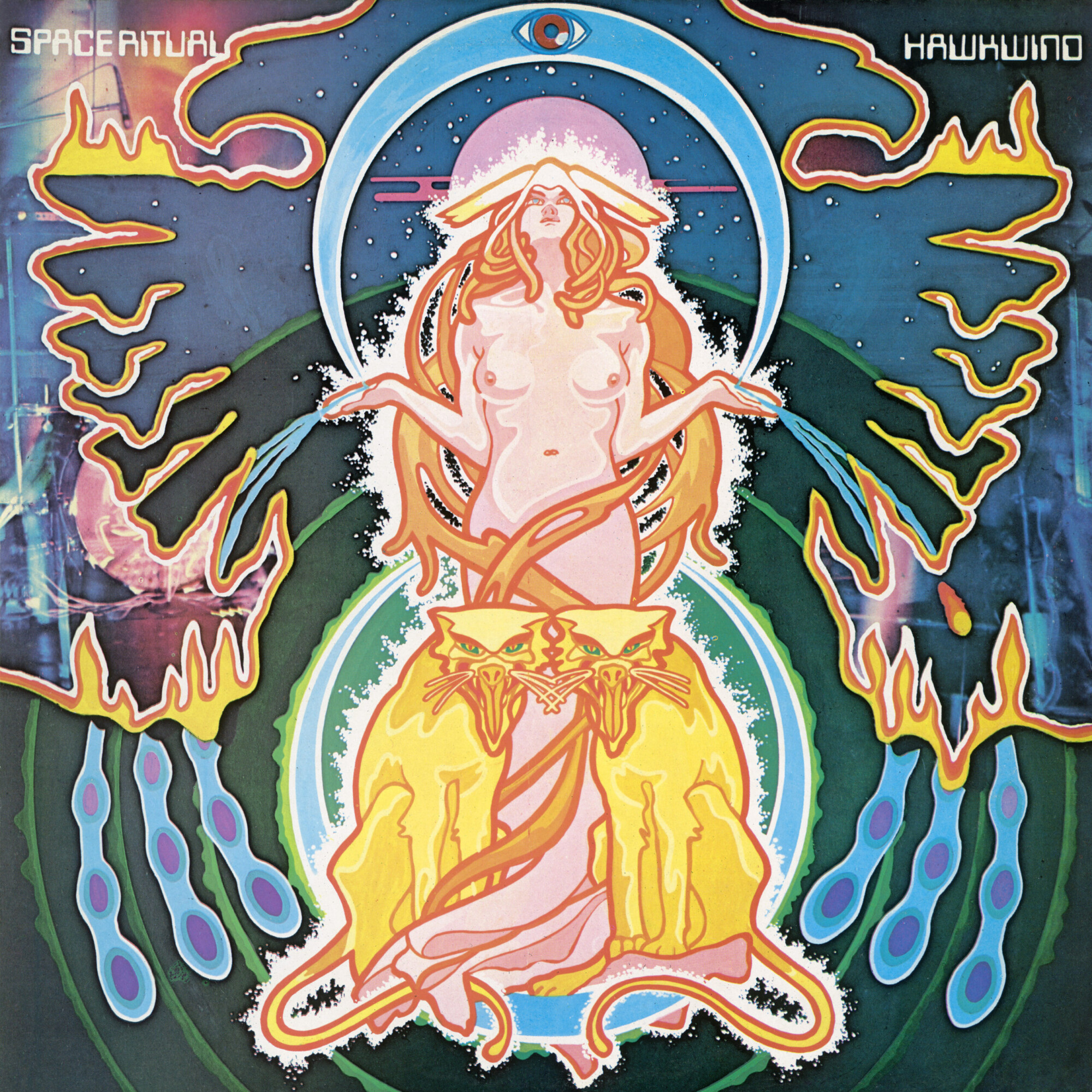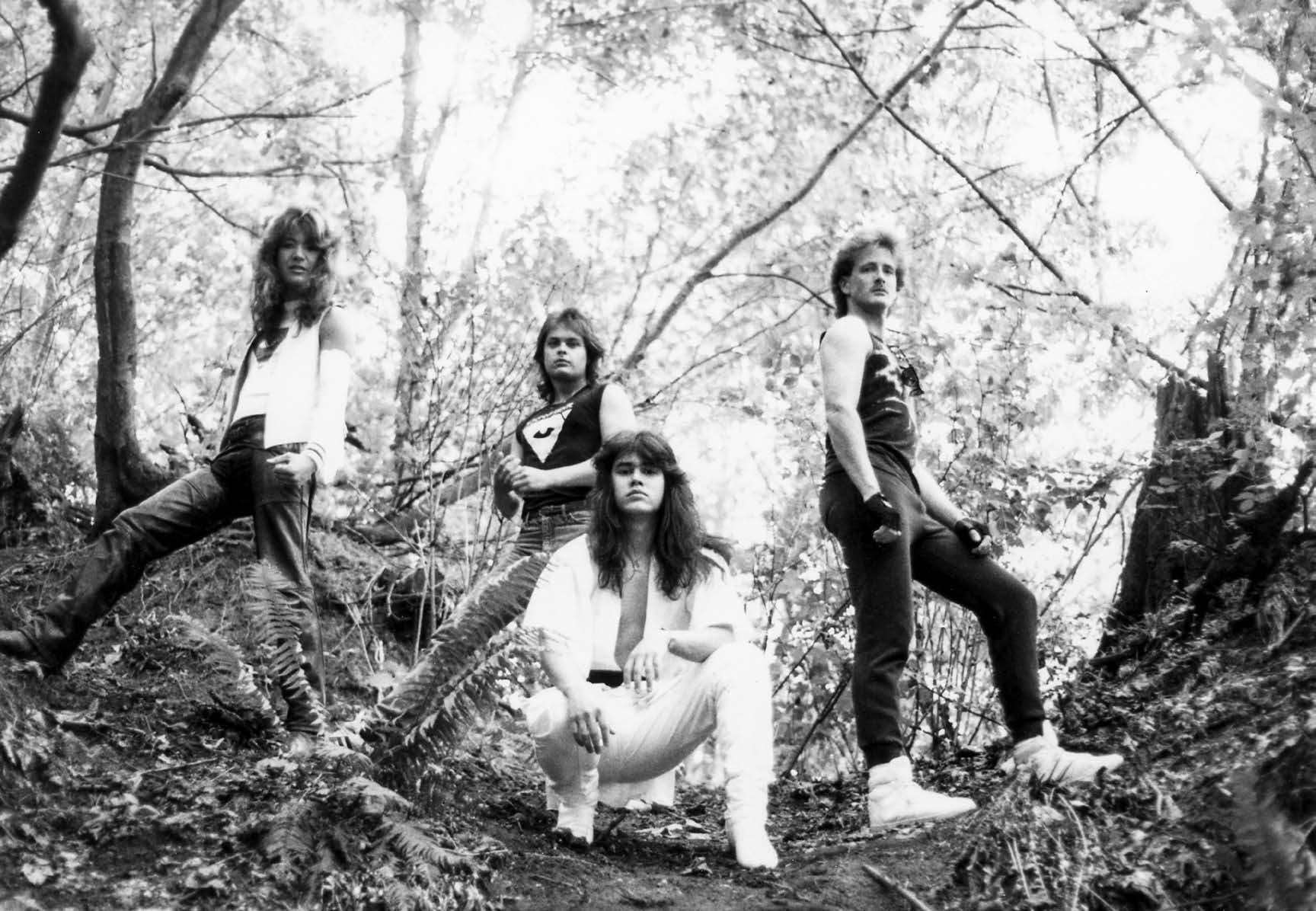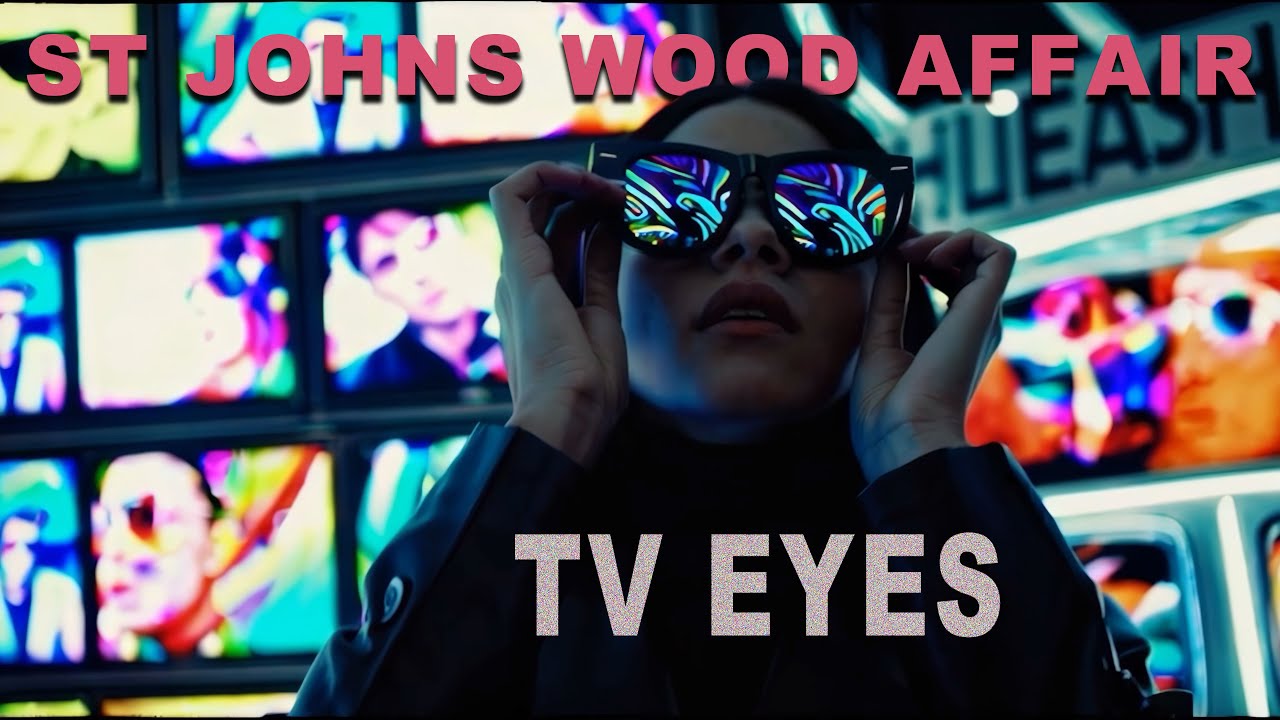Hawkwind – ‘Space Ritual 50th Anniversary’ (2023)
It’s hard to believe that the hardy genre of Space Rock first took off fifty years ago, as anniversary pods of Hawkwind’s classic live double ‘Space Ritual’ from Cherry Red Records attest.
In truth it was really a coming of age, as exploratory probes had been sent into orbit by the cosmonauts in the wake of three prototype albums by UFO from north London a couple of years earlier (appropriately on Beacon Records) charting in Germany and Japan alone. ‘Space Ritual’ remains however the ultimate space rock, less subtle perhaps but heavier and ultimately trippier, and certainly nothing to do with Pink Floyd as false histories today conflate. Space Rock in Hawkwind’s telescope owed more to German krautrock (which at least one of their bands had links to) mixed into a combustible fluid with avant-garde jazz (ditto) and the latest new electronica.
A culmination then because their birth four years earlier as Group X then Hawkwind Zoo, resulting in a debut single ‘Hurry On Sundown’ (an extended jam-like demo just appeared on the same label’s recent ‘Deviation Street’ compilation) shows they evolved into what this album and later career represent. A 1970 eponymous album’s adverts (reaching number 70 in the UK charts) proclaimed “Hawkwind is space rock” (even “90 minutes of brain damage” in those more innocent—and robust–daze!) but it wasn’t on the same plane as ‘Space Ritual’ a few years later: it was a psychedelic vehicle for three different guitarists with their own styles; more so if we include their first band Famous Cure (also with a different guitarist, the late Mike Slattery) that toured Holland in ’67. ‘X In Search Of Space’ (#18 in 1971) shows this trajectory in its title as well as content.
The “musicnauts” (as the original LP put it) were a septet: Dave Brock (vocals, guitar), Ian “Lemmy” Kilmister (vocals, bass), Simon King (drums), Nik Turner (saxophone, flute, vocals), Bob Calvert (vocals, lyrics), Dik Mik (i.e. Michael Davies, keyboards, audio generator) and Del Dettmar (EMS synthesizer and electronics). Dettmar, from Croydon, had been roadie for the Pretty Things then road manager for Edgar Broughton Band, Arthur Brown, Juicy Lucy and Cochise and had first been recruited for that role by manager Doug Smith, whose own job was recommended by John Peel at the band’s first gig in Notting Hill. Nik Turner had been added to Dave Brock’s Famous Cure (and because of his tripping sax or flute was immune to the cans of drink lobbed at him to stop when singing started), while Simon King and Lemmy (briefly) were in Opal Butterfly who recorded singles for CBS and Polydor without success.
The project grew from Calvert’s dream of a space opera and a shared idea of the universe as somehow encompassing the music of the spheres awakening a starship fuelled by the audience and its energy. Science fiction novels inspired the graphics and Michael Moorcock’s novels and poems saw his personal involvement. It developed with a large supporting cast (the “heavy metal kids”) including Barney Bubbles who designed the cover package and some but not all other art, Jonathon Smeeton (aka Liquid Lens, a light show first built for the band Traffic plus over 200 graphic slides, 50 of which came from London’s Planetarium), “Mothership Control” i.e. DJ Compere of Roundhouse and Marquee fame Andy Dunkley, Stacia, Miss Renee and Tony Carrera as dancers.
A bigger budget was due to the success of earlier albums: a fan (and Lemmy) fave was the rather silly-named ‘Doremi Faso Latido’ which landed at #14 in the month the Space Ritual Tour took place, December 1972. More of a surprise was that ‘Silver Machine,’ a Calvert/Brock single, had hit #3 in August that year, recorded live but re-dubbed with Lemmy’s vocals. BBC’s Top Of The Pops filmed a dummy excerpt of the show with the lights on at Dunstable’s Civic Hall, as well as playing the single over their Xmas show credits that year. The BBC also flew a transcription disc for worldwide radio broadcast of four ‘Ritual’ tracks plus ‘Silver Machine’ recorded at the Paris Theatre in London just prior to the tour.
These all led to the Space Ritual Tour’s bigger venues and a later American shindig as the space bandits’ cosmic immersion for stage and audience saw a party that was more bikers on acid in your face than flowers in your hair. An almost elemental audio of heavy riffing and psychedelic tripping around the thundering core of a power trio meant spaceship Hawkwind really rocked like nothing before as it sought to defy gravity. No map, let alone a chart, just interstellar exploration.
They rehearsed at the famed Middle Earth club in London’s Covent Garden prior to the tour launch in November 1972 at King’s Lynn Corn Exchange. A free comic programme, mainly by Bubbles, was handed to attendees before a 20-minute intro (a repetitive chant by Calvert such as “This is your captain speaking…” building up to “Your captain is dead”) before lift-off with ‘Born To Go,’ ‘Brainstorm’ or ‘Seven By Seven’. Non-stop music, lights, dancing and visuals (landscapes, sci-fi book covers, mandalas, even silent film horror scenes) created a lunar-pull of audience and spectacle as if a single organism of vibration I recall, as flashing colours linked to a keyboard console seemed like a wave motion with musical crescendos either side of patterns of floating lulls. An almost symphonic breadth of emotions was enhanced collectively by visual illusions, fleeting images and light-play while the band expanded consciousness in the shadows, like an opera without ego, a sort of paganized posturing-free Wagner achieving breathless effect. It’s a pity no film exists, Turner told Mojo.
The LP was recorded by Vic Maile (who engineered Who’s ‘Live At Leeds,’ Hendrix, Dr Feelgood and Motorhead’s ‘Ace Of Spades’) on 16-track with the Pye Mobile at Liverpool Stadium (a Xmas show) and Brixton Sundown as the year closed. At least that’s what the original LP says, including an Australian double cassette, before multiple reissues every decade since including FLAC. Others mention the Sunderland Locarno gig from the day after Liverpool, as does this new box. The double hit #9 and silver after release in May ’73, despite no ‘Silver Machine,’ just two weeks after performing at the old Empire Pool Wembley.
This is rather by-the-by in this case though, because Cherry Red’s Atomhenge acolytes have expanded a limited edition ‘Ritual’ to a stellar 10 CDs and a Blu Ray disc, remastering the original plus a new 5.1 Surround mix by Stephen Tayler (who’s done Moody Blues, VDGG, Marillion) which means that ‘Brainstorm’ and ‘Time We Left This World Today’ are restored to their first recorded lengths, as on ‘Space Ritual Vol.2’ in 1985, with one encore heard way back on ‘Roadhawks’ (1976). A 68-page illustrated booklet with a repro of the original poster-format tour programme comes with the full edition, a period booklet without liner notes (alas like the band’s website which still lacks a discography) for the two CDs of the original double plus uncuts and encore. A transparent double vinyl set is also out. For a band with a hundred albums including compilations and off-shoots as well as a dozen live sets spanning aeons (I mean decades) this is a new experience.
The album was initially mixed at Olympic Studios, a former cinema in Barnes near Putney London that pioneered design-technology including four-track. Brock recently said the band were all on LSD hence it being “a bit messy in places, but that’s the way it was then”. It opens with Calvert’s eery ‘Earth Calling’ leading into ‘Born To Go’ (sometimes ‘Brainstorm’ or ‘Seven By Seven’) for a ten minute comet-buzz of swirling wah-wah soloing and drum rolling propane, before the lull of Brock singing his ‘Down Through The Night’ in short rhyming couplets like the later ‘Lost Johnny,’ bumped with lurching bass and reminiscent of the debut LP, before ‘The Awakening’ close the first side.
The overdrive chugging of ‘Lord Of Light’ blitzes in from recent release ‘Doremi…’ as does the joyful chord sweep—almost ’60s in feel were it not for the spacey lyrics—of ‘Space Is Deep’ as the rock alternates with almost baroque choral harmonies split by Moorcock’s ‘Black Corridor,’ amusingly spoken among windy bleeps as if the ’80s had arrived. ‘Space age Electronic #1’ closed the vinyl’s second side but CD 1 continues breathlessly with the sax-inflected and drum-pounded ‘Orgone Accumulator’ loosely based on the discoveries of maverick—and probably silenced—psychologist Wilhelm Reich (all head shops had his work at the time), a little overstaying its welcome until guitar solos in various modes stratospheres proceedings. The air punching ‘Upside Down’ points to future sound explorations.
Calvert’s hypnotic ‘Ten Seconds Of Forever’ worked as a fuse detonating the sonic crescendo of ‘Brainstorm’ from the current album. Not many poems can render a rock audience silent followed by flying with this proto-metal classic; it’s impossible to describe the affect this new propulsion made, not because of its minimal chords but its visceral energy stretching 13 minutes here and closer to its studio version. ‘Seven By Seven’ opened the original’s final side with a raucous bellow of fun, as if orbiting the destination planet, drifting into ‘Sonic Attack’ by the novelist Michael Moorcock, which came out as a promo-only single in a special sleeve. Its wry advice for the impending apocalypse has come full-circle.
‘Time We Left The World Today,’ restored to its expansive original size (i.e. doubled) opens dreamily then lifts into the literal launch-thrust of one of their all-time classics—probably space rock’s zenith—’Master Of The Universe,’ the only track from their first two albums apart from encores featured in the ‘Ritual’. It also had its own lightshow specially prepared. Co-writer Nik Turner (with Dave Brock) recently described it “as if written on the back of a fag packet or something,” (Mojo) though they also disparaged Silver Machine (sometimes singing it live as Washing Machine!) so we can assume there is some tongue-in-astronaut-helmet involved. After all, Free, Medicine Head, and Black Sabbath described their first hits in the same way. The spectacle closed with a briefly spoken ‘Welcome To The Future,’ and sometimes an encore. The one here (‘You Shouldn’t Do That’) is longer than on ‘Roadhawks’ in 1976. If you were there, ‘Space Ritual’ embedded itself in your DNA, like an alien abductor’s microchip. There were more pedals and gizmos than a dalek factory, more bum notes than those fleeing it, but the spectacle defied criticism. It was just an experience.
The near two-hour extravaganza crossed for a European tour and then partly for an inaugural 10-date US landing the next year. Although quite low budget compared to today’s stage shows, it was costly to transport in that bygone era before jet tours and luxury bourgeois cruises. After the album’s release and another that was part live (again at Edmonton’s Sundown in January ’74) titled after a Portobello Road café—International Times was printed upstairs—and the music of Edvard Grieg (‘Hall Of The Mountain Grill’ #16, 1974), a follow-up single ‘Urban Guerrilla’ was withdrawn due to BBC censorship during the IRA’s terrorism. By 1975’s Reading Festival it had become a memory, though like all good cosmic events was memorable for its luminous trajectory.
Bob Calvert found it difficult to leave his character persona behind, even all night, and left suffering mental issues but making two superb solo concept albums. Dik Mik also left before the Moorcock-linked ‘Warrior On The Edge Of Time’ (#13, 1975, their last on the Billboard chart) then Del Dettmar too, Simon House (ex-High Tide) replacing him. New drummer Simon King berated me once when I linked the band to the organizer of an Essex charity festival that “we don’t play for free; do you think Bowie ever plays for free?” expletives removed. On the stateside tour, Lemmy was jettisoned without a parachute when arrested for drugs, soon starting Motorhead named after the last song he wrote for them. Hawkwind’s return to earth resulted in a change of label to Charisma Records, one of the few with a reputation for music that pushed boundaries.
Creativity spans time and space in one way or another because borderless, continuous, as (so far) are various interstellar projects around the world. It’s hard today to think that this album predates the Voyager probes and their still-active journey in the same year the Skylab space station was launched to cruise at five miles per second. Just as the two Voyagers’ computer power was less than a modern I-phone back then, so was the audio gear, yet still they work. When do you think this was written: ”Now, what shall we call this new sort of gazing-house / That has opened in our town where people sit / Quietly and pour out their glancing / Like light, like answering?”…in the thirteenth century by the Persian mystic Rumi. Encountering expressions of a vision can be uplifting, with its own bewilderment. Clearly, art like travelling has countless routes, and ‘Ritual’ crosses time and space from past to future.

‘Space Ritual’ was in its way groundbreaking and hasn’t been surpassed in its niche. Some later styles owe their first sparks to the rings oscillating from this live LP, a format which didn’t really sell before ’73 so were usually issued as enticements (e.g. doubles etc.) or budget-priced, such as Pink Floyd’s ‘Relics,’ ‘Genesis Live,’ the overblown triple ‘Yessongs’ or stablemates Man’s modest (and police-closed!) ‘Xmas At The Patti’. Most magazines and websites list this LP as too important to be missed: if you like your rock to buzz emotions across the fun-to-thought spectrum, climb aboard this timeless trip.
Brian R. Banks
Hawkwind – ‘Space Ritual 50thAnniversary’ (Atomhenge ATOMCD 21054)





While definitely not on the level of their better-known and more talented peers Hawkwind were a fine group and “Space Ritual” is one of the more interesting and representative recordings of its era. The new box set looks good, glad to see the album got its retrospective.